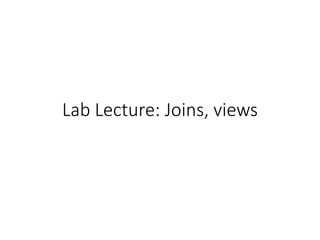
Joins and Views.pptx
- 1. Lab Lecture: Joins, views
- 2. General SELECT statement Select <List of Columns and expressions (usually involving columns)> From <List of Tables & Join Operators> Where <List of Row conditions joined together by And, Or, Not> Group By <list of grouping columns> Having <list of group conditions connected by And, Or, Not > Order By <list of sorting specifications>
- 3. Joins • We can refer to multiple tables using SELECT. • There are 5 types of JOIN: • INNER JOIN • FULL OUTER JOIN • LEFT OUTER JOIN • RIGHT OUTER JOIN • CROSS JOIN
- 6. INNER JOIN • This is one of the more frequent types of joins • Finds all rows which meet the join condition • Create the result-set by combining all rows from both the tables where the condition satisfies i.e value of the common field will be same.
- 7. Syntax: INNER JOIN SELECT table1.column1,table1.column2,table2.column1,.... FROM table1 INNER JOIN table2 ON table1.matching_column = table2.matching_column; • Here: • table1: First table. • table2: Second table • matching_column: Column common to both the tables. • We can also write JOIN instead of INNER JOIN. JOIN is same as INNER JOIN.
- 8. Example: INNER JOIN • Write an SQL query to show the names and age of students enrolled in different courses. SELECT StudentCourse.COURSE_ID, Student.NAME, Student.AGE FROM Student INNER JOIN StudentCourse ON Student.ROLL_NO = StudentCourse.ROLL_NO;
- 9. LEFT OUTER JOIN • Contains all records between T1 and T2 that meet the join condition, and then any records in T1 that don’t meet the join condition • Rows for which the join condition is not met, the columns of T2 are padded with nulls • Also known as Left Join
- 10. Syntax: LEFT OUTER JOIN SELECT table1.column1,table1.column2,table2.column1,.... FROM table1 LEFT OUTER JOIN table2 ON table1.matching_column = table2.matching_column; • Here: • table1: First table. • table2: Second table • matching_column: Column common to both the tables. • We can also write LEFT JOIN instead of LEFT OUTER JOIN.
- 11. Example: LEFT OUTER JOIN SELECT Student.NAME,StudentCourse.COURSE_ID FROM Student LEFT JOIN StudentCourse ON StudentCourse.ROLL_NO = Student.ROLL_NO;
- 12. RIGHT OUTER JOIN • Contains all records between T1 and T2 that meet the join condition, and then any records in T2 that don’t meet the join condition • Rows for which the join condition is not met, the columns of T1 are padded with nulls • Also known as RIGHT JOIN
- 13. Syntax: RIGHT OUTER JOIN SELECT table1.column1,table1.column2,table2.column1,.... FROM table1 RIGHT OUTER JOIN table2 ON table1.matching_column = table2.matching_column; • Here: • table1: First table. • table2: Second table • matching_column: Column common to both the tables. • We can also write RIGHT JOIN instead of RIGHT OUTER JOIN.
- 14. FULL OUTER JOIN • Contains all records between T1 and T2 that meet the join condition, and the combination of a left outer join and right outer join are appended onto the results. • The rows for which there is no matching, the result-set will contain NULL values.
- 15. Syntax: FULL OUTER JOIN SELECT table1.column1,table1.column2,table2.column1,.... FROM table1 FULL OUTER JOIN table2 ON table1.matching_column = table2.matching_column; • Here: • table1: First table. • table2: Second table • matching_column: Column common to both the tables. • We can also write FULL JOIN instead of FULL OUTER JOIN.
- 16. Cross join • Cross joins have no join condition • Cross joins literally return the Cartesian product of the rows.
- 17. Syntax: CROSS JOIN SELECT table1.column1,table1.column2,table2.column1,.... FROM table1 CROSS JOIN table2; • Here: • table1: First table. • table2: Second table • matching_column: Column common to both the tables. • Note that there is no ON keyword. • Try to add WHERE clause at the end and see results.
- 18. Explicit vs Implicit Joins • Explicit Joins SELECT * FROM AddressBook a INNER JOIN CallList c on a.id = c.addressBookId; • Implicit Join SELECT * FROM AddressBook a, CallList c WHERE a.id = c.addressBookId; • You can use any one you like.
- 19. Views •A view is kind of like a virtual table • Views are defined as queries (SELECT statements) • They can be queried like tables
- 20. Syntax: VIEWS CREATE VIEW view_name AS SELECT column1, column2..... FROM table_name WHERE condition; • Here: • view_name: Name for the View • table_name: Name of the table • condition: Condition to select rows
- 21. View example CREATE VIEW StudentNames AS SELECT Roll_no, name FROM Student WHERE Roll_no > 3 • This would create a view that contains names and roll number from table: Student • You can further query this view. For example: SELECT * FROM StudentNames; • Similarly views can be created from different tables.
- 22. Questions 1. Write a query that returns the account ID for each nonbusiness customer (customer.cust_type_cd = 'I') with the customer’s federal ID (customer.fed_id) and the name of the product on which the account is based (product.name). 2. Construct a query that finds all employees whose supervisor is assigned to a different department. Retrieve the employees’ ID, first name, and last name.